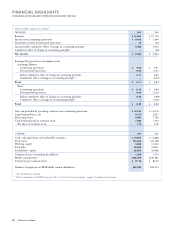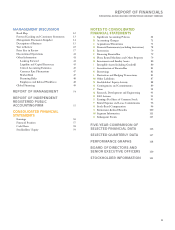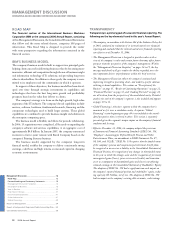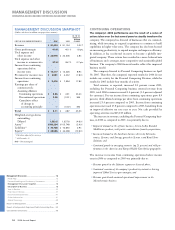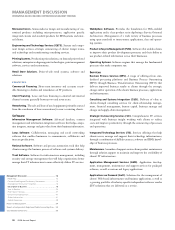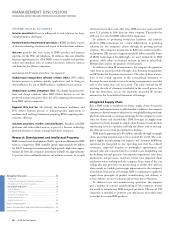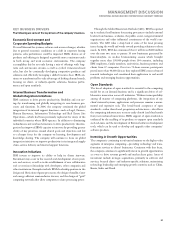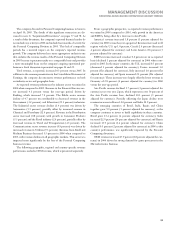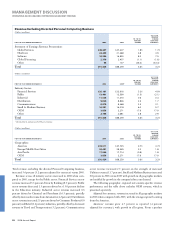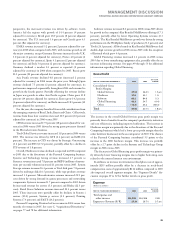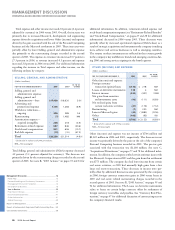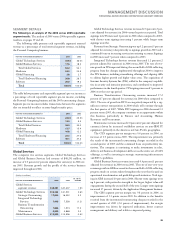IBM 2006 Annual Report Download - page 21
Download and view the complete annual report
Please find page 21 of the 2006 IBM annual report below. You can navigate through the pages in the report by either clicking on the pages listed below, or by using the keyword search tool below to find specific information within the annual report.BUSINESS SEGMENTS
Organizationally, the company’s major operations comprise a
Global Technology Services segment; a Global Business Services seg-
ment; a Systems and Technology Group segment; a Software segment;
and a Global Financing segment.
Global Services is a critical component of the company’s strategy
of providing insight and solutions to clients. While solutions often
include industry-leading IBM software and hardware, other suppliers’
products are also used if a client solution requires it. Contracts for
IBM services—commonly referred to as “signings”—can range from
less than one year to over 10 years. Within Global Services there are
two reportable segments: Global Technology Services and Global
Business Services.
Global Technology Services (GTS) segment primarily reflects infra-
structure services, delivering value through the company’s global
scale, standardization and automation. It includes outsourcing ser-
vices, Integrated Technology Services and Maintenance.
Global Business Services (GBS) segment primarily reflects profes-
sional services, delivering business value and innovation to clients
through solutions which leverage industry- and business-process
expertise. It includes consulting, systems integration and Application
Management Services.
Systems and Technology Group provides IBM’s clients with
business solutions requiring advanced computing power and storage
capabilities. Approximately 55 percent of the Systems and Technology
Group’s server and storage sales transactions are through business
partners; approximately 45 percent are direct to end-user clients, more
than half of which are through the Internet at ibm.com. In addition, the
Group provides leading semiconductor technology and products, pack-
aging solutions and engineering technology services to clients and for
IBM’s own advanced technology needs. While not reported as external
revenue, hardware is also deployed to support services solutions.
Software consists primarily of middleware and operating systems
software. Middleware software enables clients to integrate systems,
processes and applications across a standard software platform. IBM
middleware is designed to open standards which allows the efficient
integration of disparate client applications that may have been built
internally, or provided by package software vendors or system integra-
tors. Operating systems are the software engines that run computers.
In addition, Software includes Product Lifecycle Management soft-
ware which primarily serves the Industrial sector. Approximately 25
percent of software transactions are sold through business partners.
Also, 50 percent of external software revenue relates to one-time
charge (OTC) arrangements, whereby the client pays one up-front
payment for a perpetual license. The remaining annuity-based revenue
consists of both maintenance revenue sold with OTC arrangements, as
well as revenue from software sold on a recurring license charge
arrangement. Typically, arrangements for the sale of OTC software
include one year of maintenance. The client can also purchase ongoing
maintenance after the first year, which includes product upgrades and
technical support. While not reported as external revenue, software is
also deployed to support services solutions.
Global Financing is described on pages 49 through 53.
IBM WORLDWIDE ORGANIZATIONS
The following three companywide organizations play key roles in
IBM’s delivery of value to its clients:
• Sales & Distribution Organization and related sales channels
• Research, Development and Intellectual Property
• Integrated Supply Chain
Sales & Distribution Organization
With a comprehensive knowledge of IBM’s business and infrastructure
solutions, as well as the products, technologies and services IBM and its
business partners offer, the company’s global client teams gain a deep
understanding of each client’s organizational, infrastructure and indus-
try-specific needs to determine the best approach for addressing their
critical business and IT challenges. These professionals work in inte-
grated teams with IBM consultants and technology representatives,
combining their deep skills and expertise to deliver high-value solutions
that address clients’ pain points and innovational aspirations.
To facilitate its access to clients and local markets and to improve
productivity, the Sales & Distribution organization utilizes geographic
organizations in the Americas, Europe/Middle East/Africa (EMEA)
and Asia Pacific geographies. This structure enables resources and
decision making to be closer to the clients.
The majority of IBM’s revenue, excluding the company’s original
equipment manufacturer (OEM) technology business, occurs in
industries that are broadly grouped into six sectors:
• Financial Services: Banking, Financial Markets, Insurance
• Public: Education, Government, Healthcare, Life Sciences
• Industrial: Aerospace and Defense, Automotive, Chemical and
Petroleum, Electronics
• Distribution: Consumer Products, Retail, Travel and Transportation
• Communications: Telecommunications, Media and Entertainment,
Energy and Utilities
• Small and Medium Business: Mainly companies with less than
1,000 employees
MANAGEMENT DISCUSSION
INTERNATIONAL BUSINESS MACHIN ES CORPORATION AND SUBSI DIARY COMPANIES
19
Black
MAC
2718 CG10



